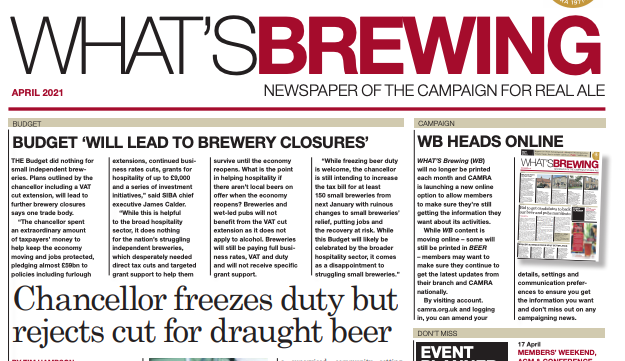The door’s ajar at the Last Chance Saloon

The grim spectre of Covid still has its bony hand on our shoulders. The impact of the pandemic and the lockdowns that followed delivered shocking blows to pubs and to draught beer.
I’m due to have my 10th or 11th anti-Covid jab this month. I’m still vulnerable. We’re all still vulnerable.
And so is draught beer, cask ale in particular. There’s cheering news from SIBA, the Society of Independent Brewers and Associates that speaks for Britain’s smaller producers. It says its members are reporting sales of cask are recovering well and in many cases are back to pre-Covid levels.
But SIBA adds an important rider – that its members are finding the route to market difficult as a result of the marketing muscle of the giant global lager brewers who dominate the British pub scene.
Between them, AB InBev, Carlsberg, Heineken and Molson Coors account for 88 per cent of the beer brewed and sold in Britain. Add in Asahi of Japan, which owns Fuller’s along with the Dark Star and Meantime brands, plus Diageo, owners of Guinness, and the percentage rises to more than 90 per cent.
In other words, the remaining small, regional and family brewers have less than 10 per cent of the market to sell to. And their struggle is made more difficult by changing consumer habits as a result of Covid.
During the lockdowns we were forced to drink at home. We bought beer from supermarkets and other retail outlets – and a lot of that beer was the global brewers’ lagers, sold with eye-watering discounts.
The habit hasn’t died. The man behind me at the Morrison’s checkout today had two slabs of Peroni, 12 cans per slab. Total price: 24 quid. Grazie, Asahi.
The habit has continued into pubs. A Greene King house in St Albans, the Speckled Hen, has Timothy Taylor’s Landlord as a guest beer. I bought a pint of Keighley’s finest and retired to a quiet corner to enjoy some pub watching. My fellow drinkers must surely follow me and order the full-flavoured Landlord.
It was late afternoon, and the pub started to fill with people coming in for a well-deserved beer after work. And every Man Jack and Jackie of them asked for lager. It was an unnerving experience.
It was no better when I went to a branch of Wetherspoon in the centre of St Albans. It’s called Waterend Barn and is made up of two enormous barns that were dismantled from a country estate in the 1930s and reassembled as a restaurant in the city centre.
Wetherspoon bought it in 2004 and spent £2m on a refurbishment. It has a vast main bar with many side rooms. There are raftered ceilings, standing timbers, beams, mullioned and stained-glass windows, chandeliers, and wood and plaster walls. There’s even a pulpit if you feel like making a speech.
St Albans has more than 50 pubs. Most that I passed were not especially busy but Waterend Barn was packed to its rafters. Unlike the Speckled Hen, the clientele here was older. They were offered the usual Spoon’s fare with knobs on – a large menu of food and beer at knockdown prices.
At the bar I was confronted by pumps with cask ales from Brain’s in Cardiff, Acorn in Barnsley, Nethergate in Suffolk and Wolf in Norfolk. In a city where a pint of cask will set you back £5 or more in most pubs, the Spoons’ beers were all less than £3.
I supped Brain’s SA Gold and surveyed the assembled masses. Yet again, no one was drinking cask. The glasses of lager were emptied and refilled as good citizens of pensionable age enjoyed the almost giveaway prices.
I could have clambered into the pulpit and proclaimed the joys of cask ale, but I fear my words would have fallen on deaf ears – and there was no shortage of those.
What can be done to redress the balance and get more people drinking and appreciating cask beer? A fine start has been made by SIBA’s Indie Beer campaign, reported in What’s Brewing.
SIBA commissioned the pollsters YouGov to conduct a survey among beer drinkers to measure their knowledge of the current beer scene.
The worrying report shows that a large number of pub-goers have no idea that the likes of Beavertown and Camden Town are owned by global lager brewers. For example, they were unaware that Beavertown’s Neck Oil and Camden’s Hells were produced by Heineken and AB InBev respectively.
The SIBA campaign will promote cask ales from genuine independent brewers with stickers attached to handpumps announcing Indie Beer. The information will also appear on bottles and cans while a new beer tracker tool via indiebeer.uk will allow people to check who owns the beers they are drinking.
CAMRA has enthusiastically endorsed Indie Beer and SIBA members are rushing to join the promotion.
In Liverpool, Carol Ross who runs the Roscoe Head – one of the Famous Five pubs that have been in every edition of the Good Beer Guide – is so alarmed by the decline of cask on Merseyside that she is taking her own urgent action.
She says “craft keg” beers are being served through handpumps and she is organising talks and tastings in her pub to promote the real McCoy. She has the full support of the local CAMRA branch.
Carol is a beer hero, and we need to follow her lead by encouraging publicans to stage talks, tastings and seminars that will encourage customers to drink quality beers brewed by genuine independents.
Pick up Carol’s torch and boost real ale before we all end up drinking in the Last Chance Saloon.

 view archive
view archive
 view events
view events